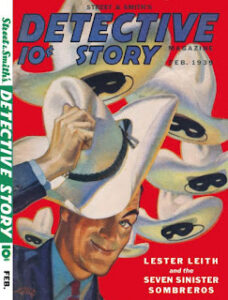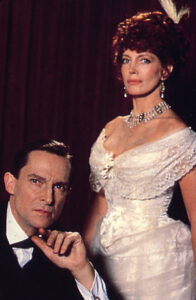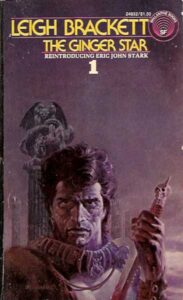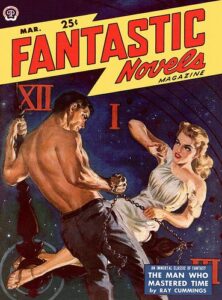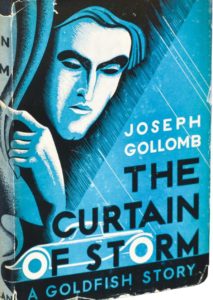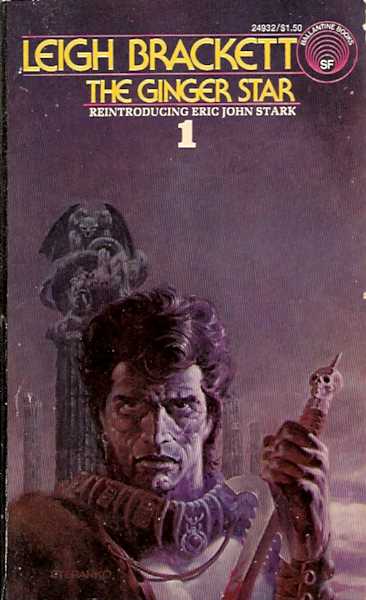
John Eric Stark, the interplanetary wildman Art by Steranko for the cover of The Ginger Star (New York: Ballantine Books, 1974).
Eric John Stark is one of the all time great Pulp heroes of any genre. The character first appeared in the 1949 summer issue of Planet Stories magazine, in the story Queen of the Martian Catacombs by pulp writer extraordinaire Leigh Brackett. Originally created as an homage/mash-up of Edgar Rice Burroughs’ characters John Carter of Mars and Tarzan of the Apes, the Stark stories contain an emotional depth and quality of prose that transcend their source materials.
It is hard to overstate how profoundly the work of Edgar Rice Burroughs affected popular fiction throughout the 20th Century. In particular the two series involving Tarzan and John Carter of Mars respectively were extremely influential. Readers of this blog are likely to be familiar with those stories to some degree. A Princess of Mars (1912) introduced John Carter, the adventurer with an unknown past who was transported in some unexplained manner to the planet Mars where he became a super-powered sword and ray gun wielding swashbuckler, and Tarzan of the Apes (1912) featuring Tarzan, the English lord lost as an infant in the African Jungle and raised by an unknown species of great apes to be a wild superman.
Following the publication of these stories, creators of fantastic narratives all over the world began to adapt their themes and styles for new pulp stories. Soon there were John Carter-esque earthmen wielding swords on alien worlds, and Tarzan-like jungle adventurers having been raised by all manner of wild animals. It is a testament to Leigh Brackett’s technical skill that she was able to merge the two themes so well, while also bringing a terse, hardboiled prose style to her writing that made the result something unique and arguably superior.
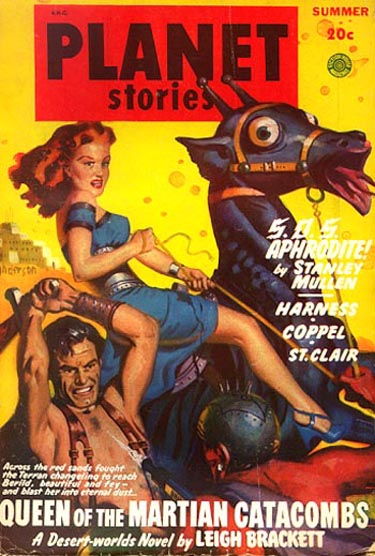
Planet Stories magazine (Summer 1949)
Of the many authors influenced by Burroughs’ stories, Leigh Brackett was one of the most talented and influential. She is best known as a screenwriter for The Big Sleep and contributing one of the first drafts for the screenplay of The Empire Strikes Back. However, she first came to the fore as a prolific writer of science fiction and fantastic adventure stories for Pulp magazines, where she somehow perfectly melded the terse, world weary style of hardboiled crime fiction with a steamily exotic alien atmosphere.
The settings the John Eric Stark stories owe much to the John Carter books. Except for the three volume Book of Skaith series published in the 1970’s, all of Stark’s adventures take place on the planets of Earth’s solar system, although, like Burroughs’ Mars, the worlds Stark visits have little in common with their real-life counterparts. The pulp writers of the 20th Century had a tendency to represent the particular planets of the solar system in similar ways. Mars was a place of intense desert, with canals that may be still in use, or may have dried up long ago. Venus was a gaseous, often jungle planet, steamy and weird. So it was with Brackett, who played with the tropes of the Pulp science fiction, and used them in building narratives of superior quality.
The Mars, Venus, and Mercury in the Stark series all have animal life, including human-like beings, some with ancient civilizations with deep history. In these settings the characters roister and roil, mostly living in a pre-industrial milieu where they fight with bladed weapons, wear sandals and robes, and rely on their own feet or beasts of burden for transportation. Science fiction technologies like ray guns, force fields, and mind-swapping devices are used in the Stark stories, but like the John Carter stories, those technologies exist only as devices to further the plots. If the settings and environments of the Stark stories are influenced by the John Carter books, they are brought to life by the force of Brackett’s prose. Brackett’s worlds, no matter how alien, are vivd with the evocative emotion and solid with the weight of their histories.
In this excerpt from from Queen of the Martian Catacombs (1949) Stark enters the Martian city of Valkis.
“Stark had never been here before. Now he looked at the city that sprawled down the slope under the low moons, and shivered, the primitive twitching of the nerves that an animal feels in the presence of death. For the streets where the torches flared were only a tiny part of Valkis. The life of the city had flowed downward from the cliff-tops following the dropping level of the sea. Five cities, the oldest scarcely recognizable as a place of human habitation. Five harbors, the docks and quays still standing, half buried in the dust.
Five ages of Martian history, crowned at the top-most level with the ruined palace of the old Pirate Kings of Valkis. The towers still stood, broken but indomitable, and in the moonlight they had a sleeping look, as if they dreamed of blue water and the sound of waves, and of tall ships coming in heavy with treasure”.
And
“Stark’s senses had developed in a strange school, and the thin veneer of civilization he affected had not dulled them. Now it seemed to him that the wind had echoes of voices in it, and the smell of spices and fresh-spilled blood”
And the action is electric with a cinematic vividness. Here from The Ginger Star (1974), Stark is in an ocean on the distant planet of Skaith, fighting for his life with a vicious, manlike sea creature that wants to eat him.
“Almost at once, Stark realized that he had made a mistake. Quite possibly, his last one. He had the advantage of surprise, but that was short-lived. In the matter of strength and reflexes he was as near animal as a man can reasonably be, but the creature he fought with was in its own element. Stark grappled with it and it shot upward from the water like a tarpon, breaking his grip. He saw it briefly above him in the cluster-light, outstretched arms shaking diamond drops, body girdled with foam. It looked down at him, laughing, and its eyes were pearls. Then it was gone in a curving arc that drove it beneath the surface. Its form was manlike, except that there seemed to be webs of skin in odd places, and the head was earless. And it was somewhere beneath him now, out of sight.
Stark rolled and dived .
The thing circled him round, flashed over him, and again was gone. It was having fun.”
In terse but visually evocative description, Brackett brings us everything we need to imagine the moment: the terrifying but graceful sea creature, Stark’s baffled attempts to fight while it toys with him. The tense rising fear that Stark feels as he confronts a powerful killer in its own element. The descriptions are focused and stochastic, like a person experiencing moments of violence. The narrative is keyed on the visual, showing us what the moment is like, to be expected from an author who had a successful career writing for motion pictures.
If John Carter of Mars provided the example for the settings of Stark’s adventures, it is Tarzan of the Apes that most directly influenced Stark’s character. Like Tarzan, Stark is a wild hero, raised by non-human animals living in the wilderness. Stark was born on the planet Mercury, in a mining colony run by an Earth corporation. His parents were killed in an avalanche in the planet’s inhospitable mountains.
Unlike Tarzan, whose childhood among the Great Apes is explored in detail, Stark’s early years and the events that led him to be rescued and raised by the furred denizens of Mercury’s shadow belt were never fully described. The only mention we have of that experience are in brief third person narrations, and descriptions of Stark’s dreams of his childhood.
Stark grew to boyhood sharing the savage life of these creatures on Mercury, climbing the vertiginous miles high cliffs and hunting the Great Rock Lizard. Enduring the bitter cold of the planet’s nights and the blistering heat of its days. The creatures that raised him are described as having snouts, and long prehensile toes, but like Tarzan’s Great Apes, they appear to be some form of proto-human, using language and “primitive” tools. They gave Stark the name “N’Chaka”, which means “man without a tribe”.
Then a tragedy that would haunt Stark’s adult life. The group of creatures Stark lived with were slaughtered by earthmen from the mining corporation. They put Stark/N’chaka in a cage and amused themselves by taunting the naked, snarling boy. That is until the arrival of Simon Ashton, a representative of the solar system’s government, rescued Stark and raised him to adulthood.
Like Tarzan and other wild-heroes , Stark’s arduous and primal upbringing gave him greater than normal strength and endurance, and a savage, non-human psychology. If we are honest with ourselves we’ll recognize that it is the extraordinary strength and athleticism of the wild hero character that makes them so attractive to us. A common wish fulfillment fantasy to be admired for the strength and muscularity for which the wild hero is characterized.
Stark’s uncivilized perspective that he shared with the creatures who raised him is fascinating. Raised by animals, the wild hero’s psychology is only lightly affected by human culture, and they often react to situations as their early savage training indicates. This non-human aspect of their thinking makes it difficult for them to engage and appreciate human society. It gives them a sense of “otherness”, which resonates with an audience who themselves feel like outsiders. Often this “otherness” is used to compare how superior the wild life is to a corrupt and decadent civilization. But not all stores with wild heroes full explore this un-human psychology that one would expect.
Tarzan, for instance, wears his otherness lightly. Certainly there are moments in the Tarzan stories where his jungle life is juxtaposed positively against the cowardly and corrupt ways of civilized society. Certainly Tarzan is different from civilized people, but he is ultimately happy with his world and his place in it. He lives with his wife on his estate in Africa with his friendly tribe of Waziri and the wealth of Opar. When he chafes at societal restrictions, he can find release in the wilds of Africa and the company of the elephants and Mangani. He knows that his human intellect will help him overcome any threat. He has the best of both worlds, and a sense of superiority in whichever world he is in.
Eric John Stark is a much less happy character. He is, more realistically considering his backstory, a true outsider, who does not fit in with human cultures at all. He and the other characters in the stories feel his otherness acutely. When in human society he is brooding and quiet, as you’d expect from someone who had to learn the subtleties of human interaction so late in life.
Another key factor in his attitude toward people is that his earliest experiences with humans showed him how cruel and evil they could be. This part of his backstory is the motivation for his way of life. He is a mercenary who will only fight on the side that he thinks is just. Usually he fights on the side of a native underdog who is suffering from colonizing invaders. He spends his energies moving from one battle to another, to protect various indigenous populations from colonial exploitation, “like a tiger going from one kill to the next”, as his adoptive father, Simon Ashton, put it.
His anger at the fate of indigenous populations at the hands of corporate imperialism makes sense psychologically with his history. Like Tarzan, the bestial aborigines who adopted him on Mercury were slaughtered by human employees of an off-world mining company. His anger of the mistreatment of pre-industrial populations and his willingness to fight it, also resonates with our idea of a hero. It is one of the things that makes Stark such an interesting Pulp hero.
Stark’s heroism is driven by a realistic sense of righteous anger. All of Stark’s recorded adventures are motivated by his desire to protect the victims of corrupt and violent oppression, as in The Queen of the Martian Catacombs, or rescue a friend from some exotic danger, as in The Enchantress of Venus (Planet Stories, Fall, 1949) or the Book of Skaith series. It is his empathy and commitment to his friends that lead him into danger and suffering.
And face danger and suffer he does. In his stories he endures torture by a band of feral warriors and survives a blinding sandstorm that leaves him lost in a blistering and trackless desert. He faces strange alien technologies that bend his mind with psychedelic experiences, and, most dangerous of all, he encounters civilized people with twisted psychologies and evil motivations. It is only Stark’s animal fortitude and primal psychology that allow him to triumph.
In Stark’s stories Brackett’s writes with a lyrical yet hardboiled style. There is evocative atmosphere and compelling action, but precious little human morality. Brackett’s stories are propelled by actual human motivations that are specific to the individual personalities of the characters. Often those drives are twisted and strange, but they are strange in ways that we recognize as realistically human.
Stark is a fascinating Pulp hero because he is a true wild hero, ferocious and primally strong, but with an emotional depth and fascination rare in Pulp fiction. The worlds Leigh Brackett creates are rich and beautifully depicted, and sing with prose both lush and cynical. The Erick John Stark stories may have been inspired by the works of another influential writer, but Brackett’s technical skill and creative power, gave them merit all of their own.
